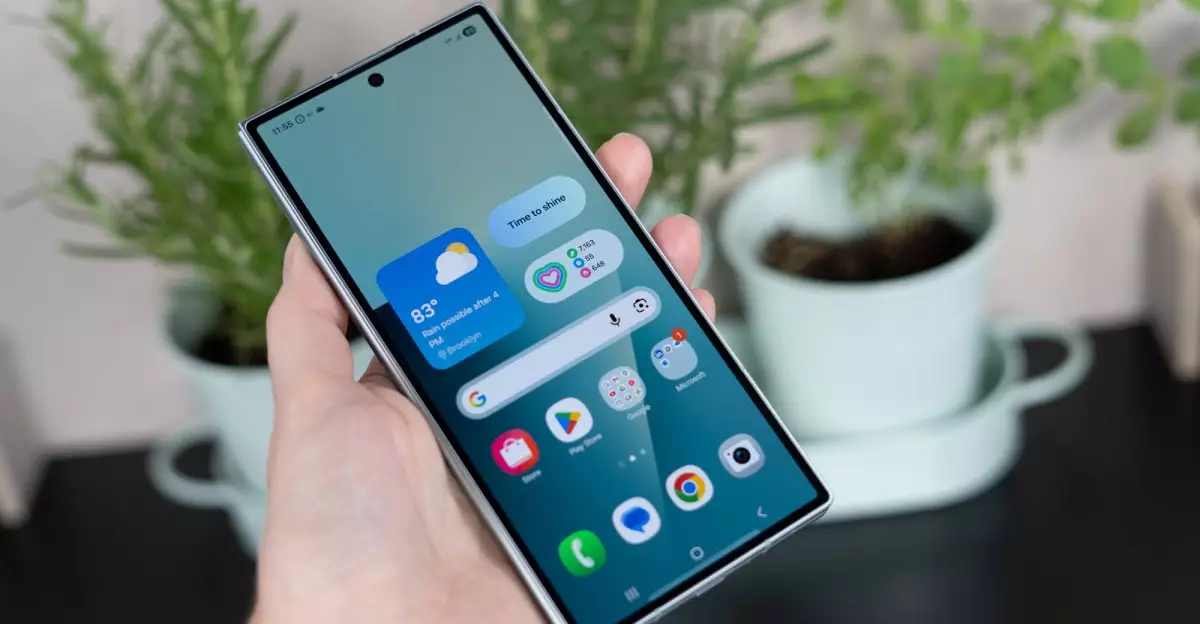The Samsung Galaxy Z Fold 7 represents a significant leap forward in foldable technology, not just in terms of innovation but also in design sophistication. Marketed as Samsung’s thinnest foldable device to date, the Z Fold 7 redefines what consumers should expect from a high-end foldable smartphone. At a mere 8.9mm when folded, it offers a sleekness that makes it feel more like a traditional phone than a bulky, novel gadget. This thinner profile addresses one of the longstanding complaints about foldables: bulkiness, which often detracts from the user experience. The incremental increase in outer screen size, now measuring 6.5 inches, enhances usability and offers a more seamless transition between phone and tablet modes. While the improvements in hardware alone are commendable, they also underscore Samsung’s commitment to bridging the gap between innovation and practicality—a device that not only looks futuristic but feels like a natural extension of daily life.
However, it’s crucial to recognize that the Z Fold 7 doesn’t drastically outpace its predecessor, the Z Fold 6, in performance. The internal upgrades are somewhat modest, which might disappoint those expecting groundbreaking technological shifts. The real selling point is its form factor—the refinement in portability and design that makes it more user-friendly and visually appealing. At the same time, consumers are faced with a substantial price tag: $1,999.99, positioning the device firmly in the premium segment. This hefty price might deter some buyers, especially considering the relatively conservative hardware upgrades. Yet, Samsung’s focus appears to be on delivering a more elegant and practical foldable rather than pushing the envelope with raw power, a strategy that many early adopters will likely find compelling.
Smart Pre-Order Strategies and Unmissable Promotions
For those eager to get their hands on the Z Fold 7, preordering is the best way to capitalize on enticing incentives, but these offers come with tight deadlines—mainly expiring at midnight on July 24th. Samsung and partnered carriers have stacked the deck in consumers’ favor with massive trade-in deals that can slash the device’s cost by up to half. The key to unlocking these savings lies in carefully understanding trade-in conditions and carrier-specific programs.
Trade-in offers are where the real value lies. Samsung’s current promotion provides up to $1,000 in instant credit if you trade in last-generation models like the Galaxy Z Fold 6 or S25 Ultra. This instantly reduces the out-of-pocket expense to around $999, a reasonable figure considering the premium features packed into the device. Even more generous are the carrier trade-in deals—Verizon and AT&T are offering up to $1,100 in monthly credits spread out over 36 months. While these plans might seem to make the purchase more affordable, they come with intricate stipulations, such as the need to qualify through specific plans or trade-in conditions. T-Mobile takes a different route by offering the same credit without a trade-in, provided you are a subscriber on an $85/month plan, showcasing a flexible approach to incentivizing customers.
Just as compelling are the online shopping perks. Preordering directly from Samsung rewards early adopters with a $50 credit for accessories or, if opted out of trade-ins, an additional $300 gift card. However, these offers are “use-it-or-lose-it”—meaning if you don’t utilize your credit at checkout, it’s forfeited. This propels consumers to plan their purchases strategically, perhaps investing in accessories, earbuds, or even the Galaxy Watch 8, ensuring they maximize the value of their investment from day one. Ultimately, the combination of trade-in incentives and accessory credits makes preordering the Z Fold 7 an enticing prospect, despite its steep initial price.
The 512GB Dilemma: Sweet Deal or Missed Opportunity?
Storage options are yet another arena where consumers need to act carefully. While the retail price for the 512GB model remains at $1,999, some retailers like Best Buy, Amazon, and T-Mobile are offering it at no additional cost through July 24th. Amazon even sweetens the deal by bundling a $300 gift card with the purchase. This is a rare opportunity to upgrade to the higher storage capacity without paying the typical premium—crucial for power users or those who want more room for media and apps.
Yet, offers vary significantly by purchase channel. Carriers like AT&T and Verizon are only offering the 256GB version at the standard $1,999 price point. Buyers opting for the carrier route should consider activation costs and plan requirements, which may impact overall savings or usability. For instance, activating through Best Buy allows purchase of the 512GB variant for $1,899.99, making it a more budget-conscious option. These varying strategies demand consumers to think carefully about their purchasing preferences—whether they prioritize immediate savings, plan flexibility, or storage space.
As the launch date approaches, it’s clear that Samsung is betting heavily on aggressive promotions. But the reality remains that the Galaxy Z Fold 7 is a premium device with a price tag that reflects its innovative, albeit incremental, advancements. For savvy consumers willing to navigate the complex promotional landscape, this could be the perfect time to make a statement—investing in a device that not only showcases cutting-edge foldable technology but also offers tangible savings if approached wisely.

